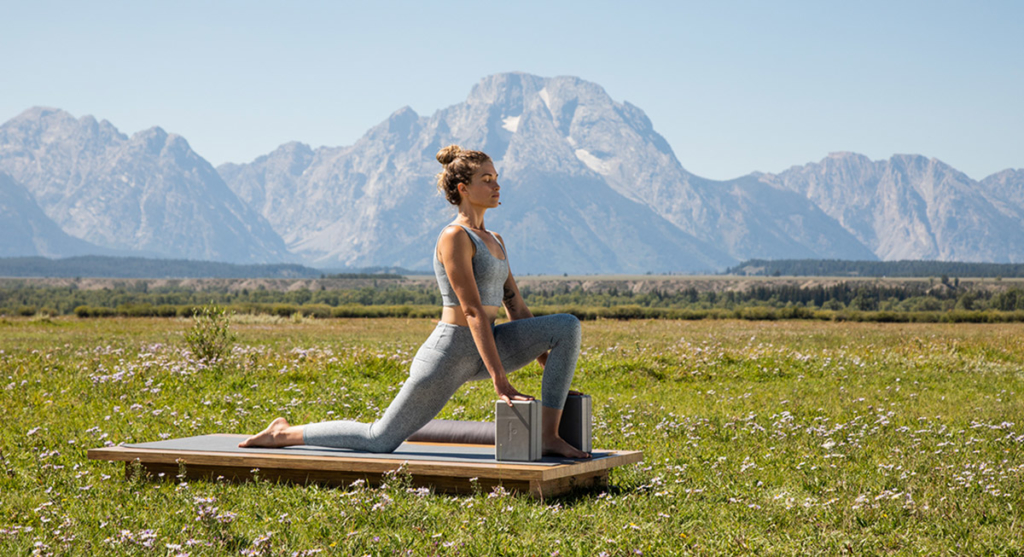
Most of us spend an awful lot of time sitting. Desk jobs may seem easy on the body, but in reality, all that sitting can wreak havoc on our physical and cognitive health. Effects of too much sitting include foggy brain due to poor circulation, weakened abdominal and gluteal muscles, neck problems from too much flexion (aka text neck), hypertension, heart disease and even possibly colon cancer. (Here’s a Washington Post chart that goes into more detail.) Yoga practice can certainly play a part in alleviating the stresses of sitting. Stretching the hip flexors is key. Crescent Lunge Pose (Anjaneyasana) is one of the most effective—and most accessible—poses for lengthening the hip flexors.
Crescent Lunge Pose helps stretch the hip flexors because the back leg is in an extended position. That is true for other lunge poses as well. But Crescent Lunge is unique in that the torso is upright. This adds a backbend to the mix, which stretches the hip flexors even further.
The Problem with Crescent Lunge
You’ve probably seen photos of bendy women practicing Crescent Lunge with their back thigh almost touching the ground. These photos may look impressive, but they make me cringe. I’m no psychic, but I do understand hip joint mechanics. When I see these photos, I can envision these same women getting hip replacements down the road.
When you allow the entire weight of your torso to bear down on the hip joint when it’s in extreme extension, you can, over time, damage the cartilage and labrum. When you collapse toward gravity in this pose, the femur head presses into the socket under extreme pressure. This wears down the cartilage and can even tear the labrum. Chances are, you won’t feel it at the time. That’s because cartilage has no ennervation. You don’t feel the damage until the cartilage is gone and your joint is bone on bone.
Stretch Your Hip Flexors AND Save Your Hips
The good news is, you can practice Crescent Lunge safely. You just need to let go of the idea that your thigh has to be hovering just inches above the ground. Yoga is not a “no pain, no gain” endeavor. You don’t have to push yourself until you feel extreme sensation. In fact, developing the sensitivity to feel subtle sensation is more indicative of “advanced” practice than is pushing yourself to an unhealthy limit. No yoga pose is worth damaging your joints!
Yoga Blocks can be key to practicing Crescent Lunge in a way that keeps your hip joints safe. Sure, you can practice safely without blocks by simply not allowing your body to collapse toward the floor. But placing your hands on Yoga Blocks helps you relax more deeply into your pose.
How to Practice Supported Crescent Lunge
There are several ways to approach Crescent Lunge Pose. I like to begin with Uttanasana (Standing Forward Bend Pose), so that’s what I’ll describe here. I like to place a folded Yoga Blanket under my back knee in this pose, especially if I’m practicing on a hard floor, but that’s optional.
Here’s what you’ll need:
- Yoga Mat
- Two Yoga Blocks
- One folded Yoga Blanket (optional)
- Place a folded Yoga Blanket across the center of your mat.
- Stand in Tadasana (Mountain Pose) at one end of your mat, facing away from the “tail” end of the mat. Place two Yoga Blocks on either sides of your feet at their tallest height.
- Bend forward from your hip joints into Uttanasana (Standing Forward Bend Pose).
- Bend your knees enough that you can place your hands on your Yoga Blocks.
- Step your right leg back so that your back foot is about a leg length from your front foot. Let your right knee come to the ground (or to your blanket). You may need to adjust the position of your blanket so that it pads your knee.
- Your left shin should be vertical or near vertical. If it’s not, adjust the distance between your front foot and back knee.
- With your hands on your Yoga Blocks, lift your torso up to vertical. Actively press your hands into your blocks, rather than collapsing into them. This creates an upward rebound that energizes the upper body.
- Take 5 to 10 deep breaths.
- Step your right foot forward into Uttanasana again. Relax here, breathing into your back.
- When you’re ready, step your left leg back and repeat Crescent Lunge on the other side.
